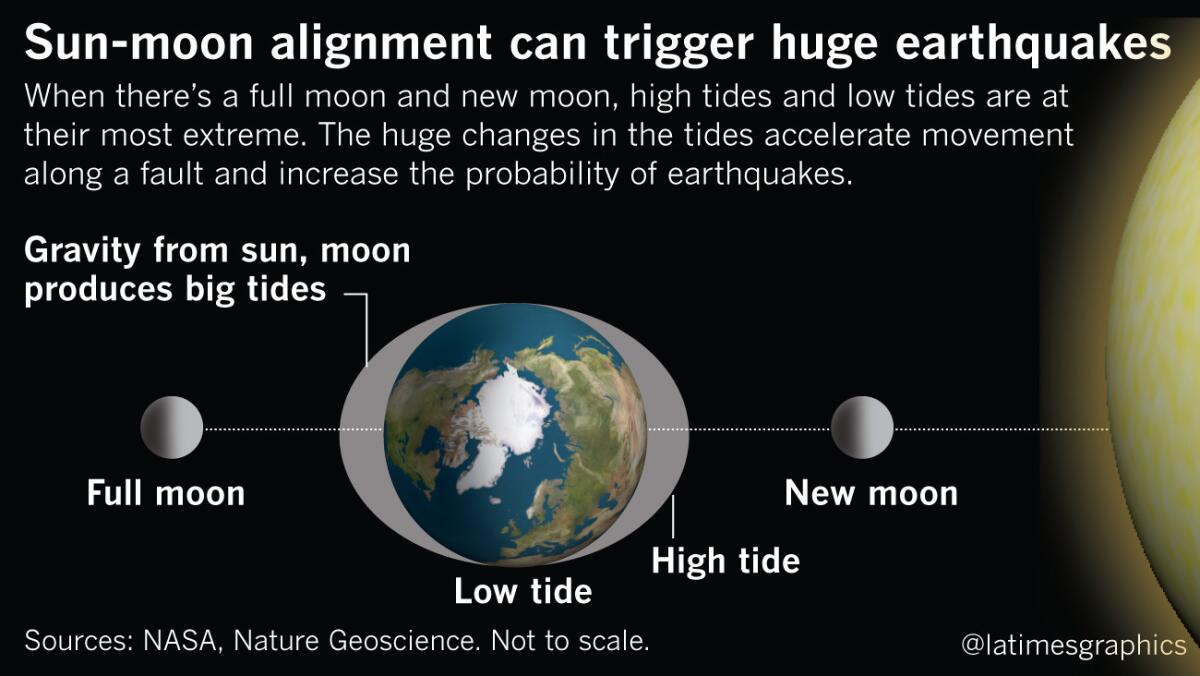How the moon and big tides could be a trigger for big earthquakes

It’s one of the most enduring mysteries in earthquake science: Why do small earthquakes stay small, while others grow into monsters?
A group of researchers offered a partial, but tantalizing answer this month: The moon and big tides.
How does this work?
The scientists zeroed in on times of high tidal stress, which can occur twice a month, during the full moon and new moon. During these moments, high tides are at their highest — flooding the tallest reaches of a beach — and about six hours later, low tides are at their lowest for the month, with seawater retreating to the farthest point toward the ocean.
This produces massive movement of ocean water and produces high tidal stress. And that tidal stress can change the stress on the fault, and, these scientists suggest, help push small earthquakes that happen to grow into very large earthquakes.
“When tides are very large, small earthquakes tend to grow,” Satoshi Ide, lead author of the report and professor of seismology at the University of Tokyo, said in an interview.
“This suggests that the probability of a tiny rock failure expanding to a gigantic rupture increases with increasing tidal stress levels,” Ide and his coauthors wrote in the report, published this month in the journal Nature Geosciences.
Or put another way: The tidal forces give a slight nudge to a fault on the cusp of rupturing.
“It could be just the amount of stress that is the ‘straw that breaks the camel’s back,’ so to speak,” said Nicholas van der Elst, a U.S. Geological Survey geophysicist. “So it makes sense that an earthquake would be more likely to happen, and coalesce into a larger earthquake, if there is just a little, additional, push.”
As a result, when tidal forces are at their largest, under this idea, “earthquakes have a slight tendency to grow larger than they would otherwise,” van der Elst said.
What are some examples of these types of quakes?
The magnitude 9.1 Indonesia earthquake in 2004 and magnitude 8.8 earthquake in Chile in 2010, which both produced damaging tsunamis, occurred around the time of a full moon, close to the peak time of tidal stress, the study said.
The research adds to a growing body of research investigating how tidal forces can affect the earth’s movement. Tidal forces — which besides the oceans also affect solid rock — are also believed to be related to small tremors deep underground along the central San Andreas fault in Monterey County, according to a study earlier this summer, which was coauthored by van der Elst.
Tidal forces, of course, are not the central reasons why an earthquake ruptures. The primary cause of earthquakes is the Earth’s moving tectonic plates, which are constantly grinding against each other. Between the tectonic plates, strain builds up on faults until the pressure is released suddenly by an earthquake.
Indeed, Ide said, many earthquakes will still happen when tidal stress is low.
“Earthquakes are nearly a random process,” Ide said. “Tidal forces are just a factor in a complex process. There are a lot of other factors.”
How can this research help earthquake safety in California?
While the Japanese study offers an idea why large earthquakes can occur, it does not help scientists predict the exact time and locations when a deadly earthquake will hit. That is widely seen as impossible to predict.
But work like this study is important to help scientists achieve a very important goal: understanding how and why large earthquakes happen.
See the most-read stories in Science this hour »
“One of the outstanding questions in seismology is: How do you get from a small earthquake to a big earthquake?” said seismologist Lucy Jones.
One idea is that they all start the same way, and whether they continue to grow depends on what they stumble into, such as tidal stress.
Another theory is that there are some other physics involved, and how large earthquakes begin is inherently different than how small earthquakes start.
Whatever the answer is, a solution would offer big rewards for the public and would improve the speed and accuracy of an earthquake early warning system for megaquakes.
How would an early warning help?
The earthquake early warning system works well in calculating, moments after an earthquake begins, the magnitudes of moderate earthquakes. Within a second of rupture, the system would calculate a magnitude of up to 4.5, and moments later, the system can calculate quickly up to a magnitude of 6 with a reasonable degree of accuracy. Beyond that, however, there’s a problem.
“The great San Andreas earthquake is going to take two minutes to happen,” Jones said. In one hypothetical scenario, she said, “at the very, very beginning of it, we’ll see that it’s at least a 6, at the Salton Sea. Forty-five seconds into it, we need to be able to recognize that we’ve now grown to a 7.5, and the fault has extended up to the San Bernardino Mountains — it’s now a lot closer to a lot of other people.”
During the 2011 Japanese earthquake — a magnitude 9.0 — that nation’s earthquake early warning system underestimated the intensity of shaking in Tokyo moments before more intense shaking waves hit the capital, Jones said.
“If we can ever solve this problem, of what makes an earthquake big — we’ll make a huge advance in what we can predict during an earthquake as it’s going on,” Jones said.
ALSO
What are the odds of dying in an earthquake?
Big earthquakes can produce destructive temblors on nearby faults, new study finds
Lack of preparation for massive earthquake could bring catastrophe, report says
Major earthquake overdue in California’s Eastern Sierra, study finds
More to Read
Sign up for Essential California
The most important California stories and recommendations in your inbox every morning.
You may occasionally receive promotional content from the Los Angeles Times.











